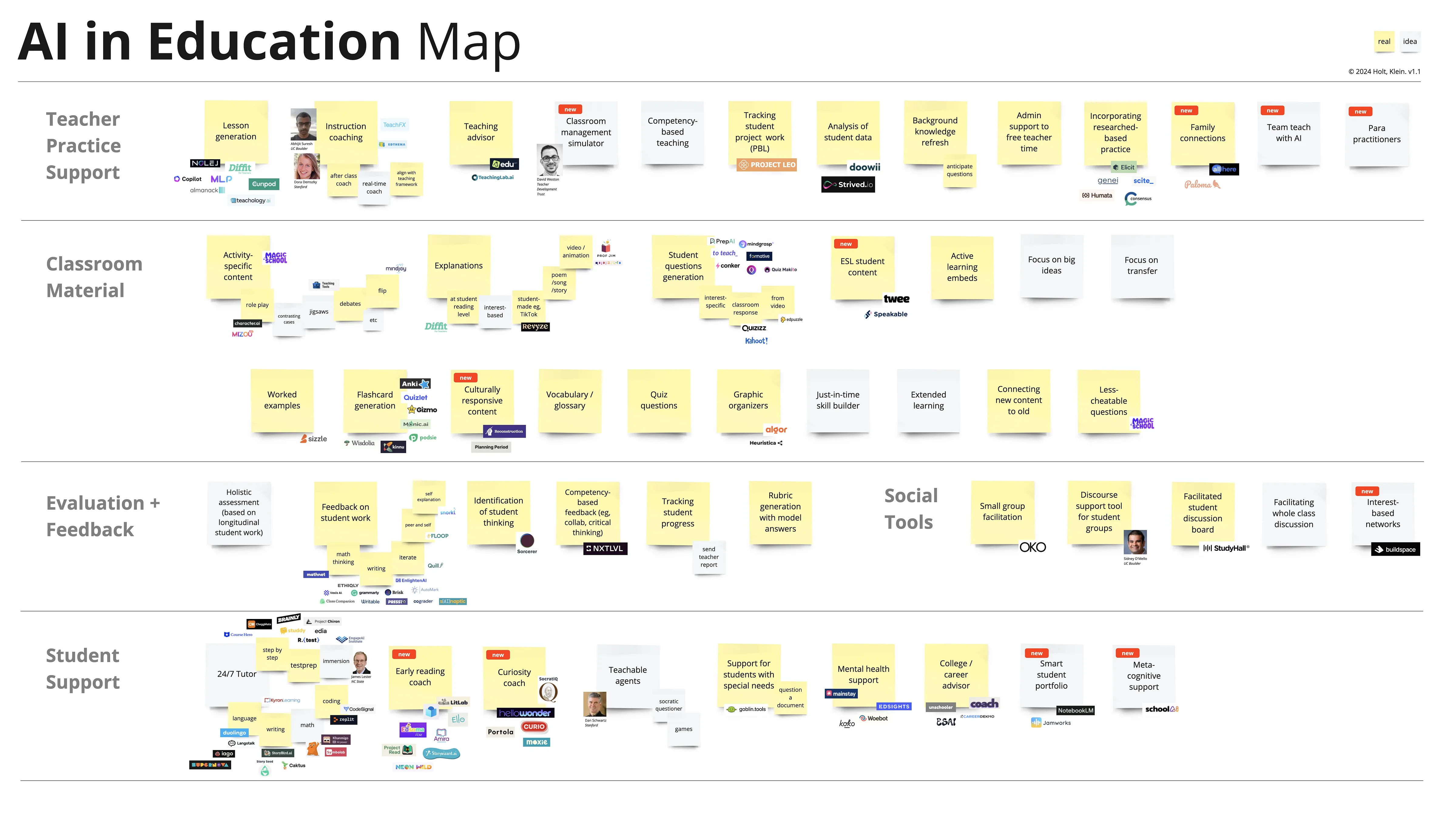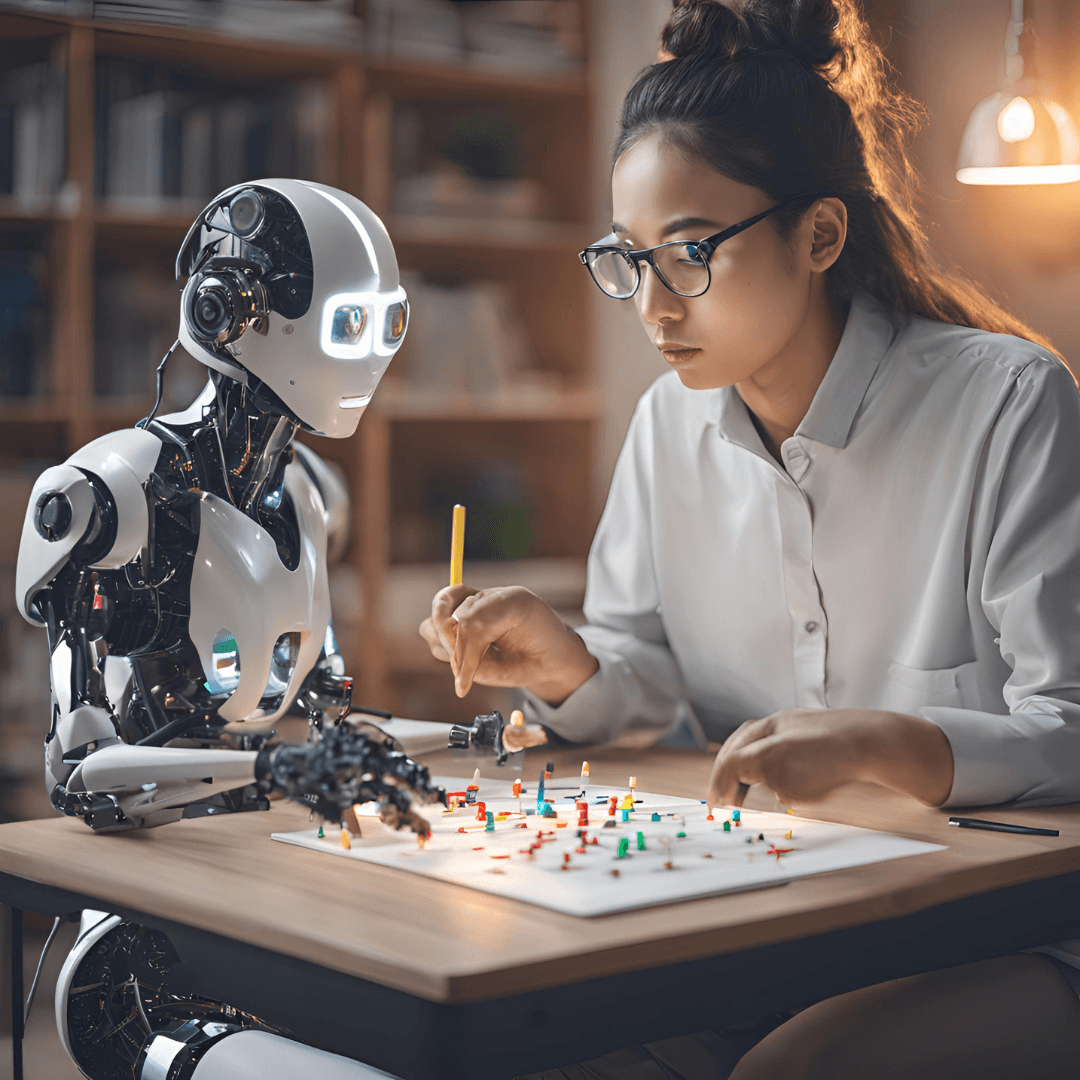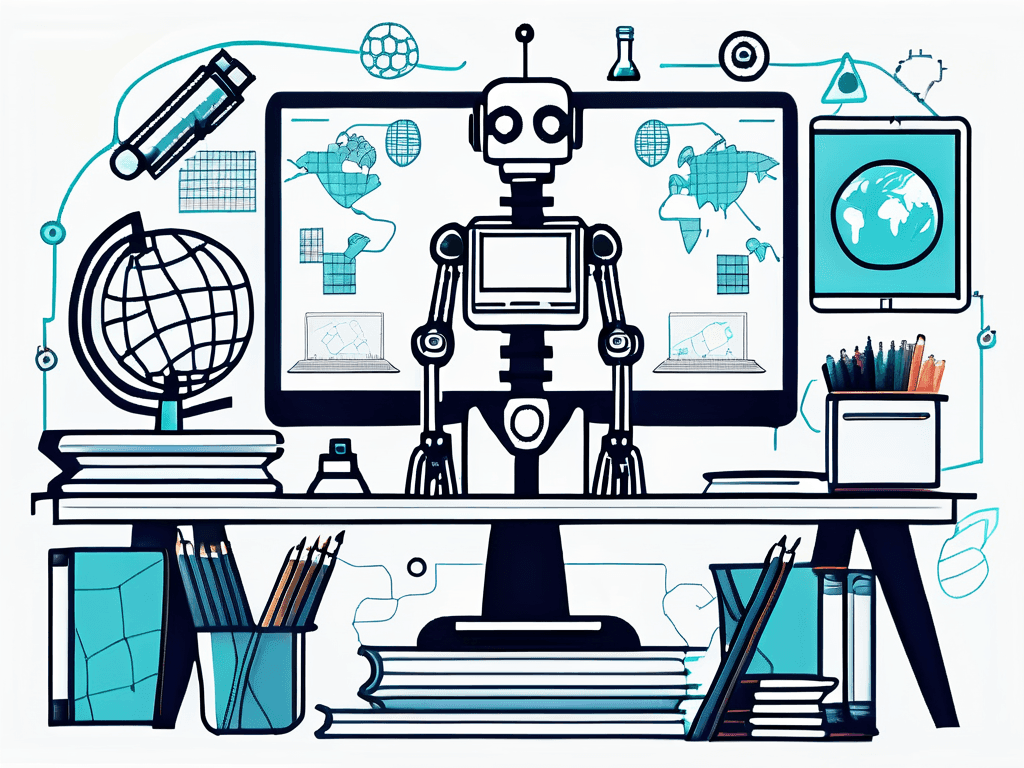Types of AI Tools for Teachers: Enhancing Education with Technology
By a Former K-12 Teacher Turned AI Aficionado
Mar 28, 2025

Artificial Intelligence (AI) is revolutionizing various industries, and education is no exception. Teachers and educators are increasingly incorporating AI tools into their classrooms to enhance the learning experience of students. By leveraging the power of technology, AI tools have the potential to transform traditional teaching methods and provide personalized learning opportunities for students. In this article, we will explore the role of AI in education, the benefits it offers, and the different AI tools available for teachers to use. We will also discuss the implementation process and the future of AI in the educational landscape.
A live preview of AI for Teachers to start the article:
The Evolving Role of AI in Education
AI refers to machines and systems that can mimic human intelligence and perform tasks that typically require human thinking. In the context of education, AI can be used to analyze vast amounts of data, provide personalized recommendations, facilitate classroom management, and enhance student assessment. It acts as a supportive tool for teachers, allowing them to focus more on interactive and creative aspects of teaching while AI handles the repetitive tasks. Let’s be very clear though, AI in education is not about replacing teachers; it's about augmenting their abilities and providing new opportunities for student success.
Click here to take yourself to the best AI Tools for Teachers
"AI is not about replacing teachers; rather, AI will allow teachers to augment their capabilities and allow them to focus more on the interactive, human and empathetic aspects of nurturing our young people" (Bush, 2023)
What is the role of Artificial Intelligence (AI) in education?
AI Can Assist Teachers in the Classroom
AI tools can assist teachers in various ways, such as automating administrative tasks, providing real-time insights into student performance, and creating adaptive learning experiences. For example, AI-powered chatbots can answer students' questions, offer adaptive practice, provide immediate feedback, and offer additional resources. Virtual reality and augmented reality technologies powered by AI can take students on immersive virtual field trips or provide 3D visualizations of complex concepts. AI can analyze student data and generate actionable insights to help teachers identify areas where students are struggling and tailor instructional materials accordingly.
Click here to take yourself to AI for Educators
The Intersection of AI and Teaching
AI tools can assist teachers in various ways, such as automating administrative tasks, providing real-time insights into student performance, and creating adaptive learning experiences. For example, AI-powered chatbots can answer students' questions, provide immediate, actionable feedback, and offer additional resources. Virtual reality (VR) and augmented reality (AR) technologies powered by AI can take students on immersive virtual field trips or provide 3D visualizations of complex concepts.
Furthermore, AI can analyze student data and generate actionable insights to help teachers identify areas where students are struggling and tailor instructional materials accordingly.
Click here to take yourself to AI for Educators
What are the benefits of integrating AI in the Classroom?
1. AI Can Assist with Creating Personalize Learning Experiences
Integrating AI in the classroom offers several benefits for both teachers and students. Firstly, it allows for personalized learning experiences. AI tools can adapt to individual students' learning styles and pace, providing customized content and exercises that cater to their specific needs. AI tools promote student engagement by offering interactive and immersive learning experiences. This can lead to increased motivation, retention, and a deeper understanding of the subject matter. Yau et al. (2022) concluded, “teachers observed that their students demonstrated an interest in AI-related topics. Student engagement increased, reflecting students’ interest in the discussions”.
Click here to take yourself to AI for Educators
2. AI Can Save Teachers Time
AI tools can save teachers time by automating routine tasks such as grading assignments or generating progress reports. This frees up valuable time for teachers to focus on engaging in activities and providing one-on-one support to students.
3. AI Can Help Develop Critical Thinking Skills and Peer Collaboration
AI can also assist in the development of critical thinking skills among students. By analyzing data and identifying patterns, AI can help students understand complex problems and develop logical reasoning abilities. This can empower students to think critically and approach challenges from different perspectives.
Click here to take yourself to AI for Educators
4. AI Can Help Create Inclusive and Accessible Education
Additionally, AI can contribute to the inclusivity and accessibility of education. For students with disabilities, AI-powered tools can provide personalized accommodations and support, ensuring that they have equal access to educational resources and opportunities. AI can also help bridge the gap between different languages and cultures, providing translation services and facilitating cross-cultural communication in the classroom.
In conclusion, the integration of AI in education holds immense potential to revolutionize the learning experience of students and the workflow of teachers. By augmenting teachers' abilities and providing personalized support to students, AI can create a more inclusive, engaging, and effective educational environment. It is important to embrace AI as a tool that complements and enhances the role of teachers, rather than a replacement. With careful implementation and consideration of ethical implications, AI can truly transform education and empower students to thrive in an increasingly digital world.
Exploring Different Types of AI Tools for Teachers
Now let's take a closer look at some of the AI tools and their available services for teachers to enhance their teaching practices:

Image Courtesy of Lauren Holt
Click here to take yourself to AI for Educators
1. AI Tools for Personalized Learning
Personalized learning is an approach that tailors teaching methods and content to meet individual students' needs. AI-powered adaptive learning platforms use algorithms to analyze students' performance and provide targeted recommendations and adaptive content based on their strengths and weaknesses. These tools help students progress at their own pace, ensuring no one is left behind.
2. AI Tools for Classroom Management
Managing a classroom can be challenging, especially when it comes to giving individual attention to each student. AI tools can assist in classroom management by automatically tracking attendance, monitoring student behavior, and even detecting signs of distress or emotional well-being. This enables teachers to provide timely support and interventions, ultimately creating a more inclusive and supportive learning environment.
Click here to take yourself to AI for Educators
3. AI Tools for Student Assessment
Assessing student performance is an essential part of the education process. AI teacher tools can streamline this process by automating grading and providing instant feedback to students. AI algorithms can analyze student responses and identify patterns, helping teachers quickly identify areas where students may need additional support.
Furthermore, AI tools for student assessment can also help in creating personalized learning paths for students based on their performance data. By analyzing the strengths and weaknesses of each student, these tools can recommend specific learning resources or activities to address individual learning gaps. This level of customization can greatly enhance the learning experience for students, making education more engaging and effective.
4. AI Tools for Lesson Planning
Lesson planning is a crucial aspect of teaching, requiring teachers to create engaging and informative lessons that cater to diverse learning styles. AI tools can support teachers in this process by analyzing curriculum standards, student performance data, and teaching objectives to suggest relevant and effective lesson plans; completely transforming the teaching experience for educators. These tools can also help in generating interactive multimedia content, quizzes, and activities to make lessons more interactive and engaging for students.
Click here to take yourself to AI for Educators
Implementing AI Tools in the Classroom
The adoption of AI tools in the classroom can be a daunting task for administrators and educators. After selecting and implementing AI tools, all users will require prolonged and sustainable support as AI continues to evolve. Here are some key considerations to keep in mind as institutions implement AI into the classroom.
1. Choosing the Right AI Tool
When selecting an AI tool for the classroom, it's important for teachers and educational institutions to consider their specific needs and requirements. They should evaluate the functionality, ease of use, and compatibility of the AI tool with their existing systems. Additionally, considering the feedback from other educators who have used the tool can provide valuable insights.

2. Provided Support from AI Developers or Vendors
When selecting an AI tool for the classroom, it's important for teachers and educational institutions to consider their specific needs and requirements. They should evaluate the functionality, ease of use, and compatibility of the AI tool with their existing systems. Additionally, considering the feedback from other educators who have used the tool can provide valuable insights.
Click here to take yourself to AI for Educators
3. Training Teachers to Use AI Tools
Integrating AI tools into the classroom requires appropriate training for teachers and educators. Antonenko and Abramowitz (2022) stress the importance of mapping K-12 teachers' existing knowledge, conceptions, and misconceptions so that these can be considered “in the design of the curriculum that introduce K-12 students to AI and ML”. When selecting an AI tool for the classroom, it's important for teachers and educational institutions to consider their specific needs and requirements. They should evaluate the functionality, ease of use, and compatibility of the AI tool with their existing systems. Additionally, considering the feedback from other educators who have used the tool can provide valuable insights.
4. Overcoming Challenges in AI Implementation
Despite the potential benefits, implementing AI tools in the classroom can pose challenges. These challenges range from concerns about job security to the ethical implications of using AI to make educational decisions. It is essential to address these concerns and ensure transparency and accountability in the use of AI tools. Collaboration between teachers, administrators, and policymakers is crucial to navigate these challenges and ensure ethical and equitable implementation of AI in education.
Click here to take yourself to AI for Educators
Additionally, establishing clear guidelines and protocols for data privacy and security is paramount when utilizing AI tools in educational settings. Safeguarding sensitive student information and ensuring compliance with data protection regulations are fundamental aspects of responsible AI integration. By prioritizing data ethics and security, educational institutions can build trust with students, parents, and the community at large.
The Future of AI in Education
AI-powered Tutors can Support and Personalize Learning
As AI continues to evolve, certain trends are likely to shape its future in education. One such trend is the increased use of AI-powered tutors and virtual assistants, providing personalized support to students outside the classroom. These AI tutors will not only assist K-12 students with their academic needs but also help them develop important life skills such as problem-solving, critical thinking, and creativity. By analyzing vast amounts of data, AI tutors can identify each student's strengths and weaknesses, tailoring their approach to ensure optimal learning outcomes. Communicative AI such as conversational agents and embodied social robots interact with students, not limited to supporting students’ cognitive development, and serve as an empathic peer/tutor to support affective development such as improving learning interest, motivation, self-regulation, and sense of empathy and collaboration (Chin et al., 2014).

The introduction of intelligent tutoring systems that can understand and adapt to students' emotional states is another predicted trend. These systems will be equipped with advanced algorithms that can detect students' emotions through facial expressions, tone of voice, and other cues. By recognizing when a student is feeling frustrated, confused, or disengaged, AI tutors can provide appropriate support and encouragement, helping students overcome challenges and stay motivated.
Click here to take yourself to AI for Educators
Additionally, AI tools may enable the creation of lifelong learning platforms, where individuals can continue to learn and upskill throughout their lives. These platforms will offer personalized learning pathways based on each individual's interests, goals, and learning style. With the help of AI, individuals will have access to a vast array of educational resources, including interactive simulations, virtual reality experiences, and real-time feedback from AI tutors.
Preparing for an AI-Driven Educational Landscape
Who should be involved in the development of AI policy and frameworks in education?
As AI becomes more prevalent in education, it is crucial for educators, school leaders, and policymakers to proactively prepare for an AI-driven educational landscape. This includes embracing new teaching methodologies that integrate AI tools seamlessly into the classroom in order to impact student learning. Teachers will become facilitators of learning, guiding students in navigating the vast amount of information available and helping them develop critical thinking skills to evaluate the reliability and credibility of AI-generated content.
Click here to take yourself to AI for Educators
Fostering interdisciplinary collaboration will also be essential in preparing for an AI-driven educational landscape. Educators, school leaders, AI developers, psychologists, and other experts will need to work together to ensure that AI tools are designed and implemented in a way that aligns with educational goals and ethical considerations. By combining their expertise, these stakeholders can create AI systems that are not only effective but also promote inclusivity, diversity, and ethical use of data.
Furthermore, ensuring access to AI tools and resources for all students, regardless of their socioeconomic background, is crucial to avoid exacerbating existing educational inequalities. Policymakers need to invest in infrastructure and resources that enable equitable access to AI technology in schools and communities. Additionally, efforts should be made to bridge the digital divide by providing training and support to educators and students, empowering them to make the most of AI tools and resources.
Click here to take yourself to AI for Educators
Conclusion
In conclusion, generative AI tools have the potential to significantly enhance education by providing personalized learning experiences, developing AI-enhanced educational content, improving classroom management, providing real-time feedback, and facilitating student assessment. However, it is important to approach the implementation of generative AI in education with careful consideration and collaboration. By utilizing the power of AI technology in an ethical and responsible manner, teachers can implement these tools to create engaging, inclusive, and effective learning environments for students. The future of AI in education holds great promise in transforming educational experiences, and by embracing this technology, we can empower the next generation with the skills and knowledge they need to thrive in an ever-evolving world.
References
Antonenko, P., & Abramowitz, B. (2022). In-service teachers’ (mis)conceptions of artificial intelligence in K-12 science education. Journal of Research on Technology in Education, 1–15. https://doi.org/10.1080/15391523.2022.2119450
Bush, Christopher (2023, December 17). AI in the Classroom: Shaping the Future of Education. National Education Summit. https://www.nationaleducationsummit.com.au/nes-blog/ai-in-the-classroom-shaping-the-future-of-education
Chin, K. Y., Hong, Z. W., & Chen, Y. L. (2014). Impact of using an educational robot-based learning system on students’ motivation in elementary education. IEEE Transactions on Learning Technologies, 7(4), 333–345.
Yau, K. W., CHAI, C. S., Chiu, T. K. F., Meng, H., King, I., & Yam, Y. (n.d.). A phenomenographic approach on teacher conceptions of teaching Artificial Intelligence (AI) in K-12 schools. Education and Information Technologies, 28(1), 1041–1064. https://doi.org/10.1007/s10639-022-11161-x
You may also like…

What’s the Fastest Way to Make A Reading Quiz from an Article?
Mar 30, 2025
Learn how to quickly turn any article into a custom, standards-aligned reading quiz using TeachShare’s AI-powered templates. This step-by-step guide shows teachers how to generate, customize, and share comprehension assessments in minutes—no formatting or manual writing required.

How to Modify Assignments for SPED Students with AI
Mar 30, 2025
Learn how to use AI to adapt lessons and assignments for SPED students quickly and effectively. This guide shows how TeachShare helps teachers personalize materials to meet IEP goals, add scaffolds, simplify instructions, and support diverse learning needs—without starting from scratch.
2024 TeachShare. All rights reserved.
TeachShare
Newsletter